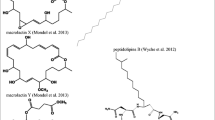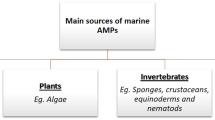Abstract
Several ecological factors of the marine environment were used in developing a strategy for discovering useful bioactive agents from marine microorganisms. By consideration of sea water requirements, production and degradation of marine polymers, and plasmid content, several novel anti-malarial antibiotics, anti-tumor polysaccharides, glucan-degrading enzymes, and aminoglycoside antibiotics were found.
Similar content being viewed by others
References
Araragi M (1979) Comparison of actinomycete flora between tropical and Japanese upland farm soils. I. Physiological characteristics. Soil Sci Plant Nutr 25:245–254
Burkholder PR, Pfister RM, Leity FH (1966) Production of a pyrrolo antibiotic by a marine bacterium. Appl Microbiol 14:649–653
Colwell RR (1983) Biotechnology in the marine science. Science 222:19–24
Demain AL (1981) Industrial microbiology. Science 214:987–995
Fenical W (1982) Natural products chemistry in the marine environment. Science 215: 923–928
Ikeda D, Gomi S, Kondo S, Umezawa H (1983) Some chemical modifications of istamycin B. J Antib 36:331–334
Mitchell R, Nevo Z (1965) Decomposition of structural polysaccharides of bacteria by marine micro-organisms. Nature 205:1007–1008
Nakamura H, Iitaka Y, Kitahara T, Okazaki T, Okami Y (1977) Structure of aplasmomycin. J Antib 30:714–719
Nisbet LJ (1982) Current strategies in the search for bioactive microbial metabolites. J Chem Tech Biotechnol 32:251–270
Okami Y (1972) New samples for collection of sea mud. J Antib 25:467–468
Okami Y, Okazaki T, Kitahara T, Umezawa H (1976) Studies on marine microorganisms. V. A new antibiotic, aplasmomycin, produced by a streptomycete isolated from shallow sea mud. J Antib 29:1019–1025
Okami Y, Hotta K, Yoshida M, Ikeda D, Kondo S, Umezawa H (1979) New aminoglycoside antibiotics, istamycin A and B. J Antib 32:964–966
Okami Y, Kurasawa S, Hirose Y (1980) A new glucanase produced by a marine bacillus. J Antib 44:1191–1192
Sato K, Okazaki T, Maeda K, Okami Y (1978) New antibiotics, aplasmomycin B and C. J Antib 31:632–635
Shigyo T, Hotta K, Okami Y, Umezawa H (1984) Plasmid variability in the istamycin-producing strains ofStreptomyces tenjimariensis. J Antib 37:635–640
Umezawa H, Okami Y, Kurasawa S, Ohnuki T, Ishizuka M, Takeuchi T, Shiio T, Yugari Y (1983) Marinactan, antitumor polysaccharide produced by marine bacteria. J Antib 36: 471–477
Author information
Authors and Affiliations
Rights and permissions
About this article
Cite this article
Okami, Y. Marine microorganisms as a source of bioactive agents. Microb Ecol 12, 65–78 (1986). https://doi.org/10.1007/BF02153223
Issue Date:
DOI: https://doi.org/10.1007/BF02153223




